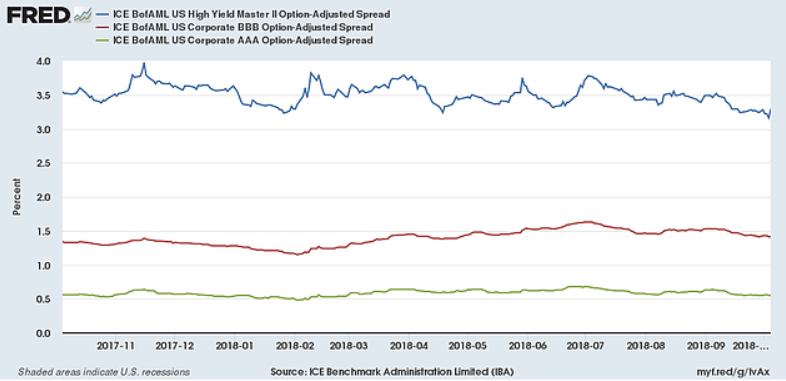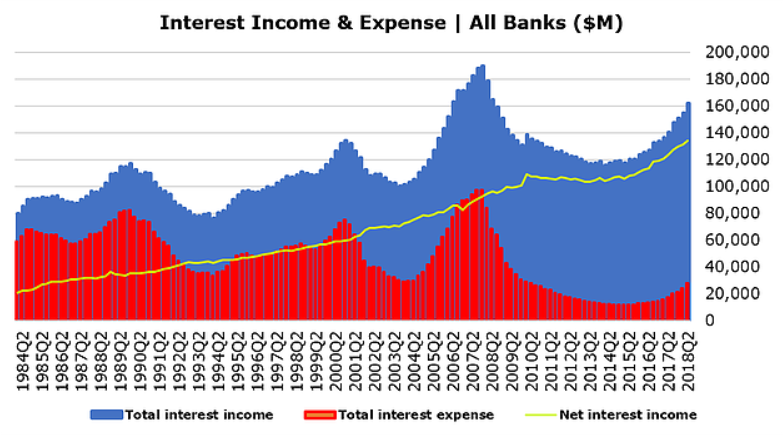Originally published at The Institutional Risk Analyst
This week The Institutional Risk Analyst ponders Q3 ’18 earnings for financials and what other surprises lie ahead. The conventional wisdom on the Street is that higher interest rates are good for banks, but it is higher SPREADS that really matter. Today, spreads are contracting as the Federal Open Market Committee forces short-term interest rates higher. There is little demand in the market for higher short-term rates, but who needs demand when you have economists?
Q: Will the FOMC’s relentless quest for “normal” as defined by the target for Fed Funds cause a liquidity squeeze among non-bank financial companies later this year or early in 2019?
The entire Treasury yield curve moved about 25 basis point higher in yield last week, a remarkably synchronized shift upward that caused many financial stocks to rise in reflexive response. Apart from an uptick in high yield spreads last week though, the corporate bond complex continues to see spreads grind lower on brisk investor demand (see chart below). And loan spreads, which compete with bond market execution and private equity, are not moving.
Meanwhile, in the world of non-bank finance, the prospect of rising rates is adding a significant burden on heavily leveraged lenders in the mortgage and consumer finance sectors. Wells Fargo (WFC), Chase and many others are shedding thousands of staff to right-size shrinking residential lending businesses. There is already a steady outflow of firms and people as smaller issuers quietly shut their doors. We estimate that a significant portion of the issuers in the GNMA market could be out of business within the year.
Last week in Washington we heard some of the biggest non-bank mortgage lenders in the US declare that while not yet concerned about credit quality today, they are very concerned about liquidity in the industry. In particular, the risk of over-leveraged developers of multi-family properties going bust is seen as a clear and present risk. By no coincidence, commercial banks are bidding aggressively for deposit business, well in excess of LIBOR plus 1%.
Related: Louis Gave on Corporate Debt and the Next Liquidity Crisis
Given that well more than half of the non-bank lenders in the residential mortgage finance space are probably in breech of loan covenants due to poor profitability, low capital or both, the question arises as to whether anyone at the FOMC is cognizant of this growing crisis. Non-banks are, after all, the customers of banks, typically the top 50 or so institutions. We wonder if Chairman Jay Powell and his colleagues on the FOMC will start to rethink the plan for boosting short-term rates further when a couple of large GNMA seller/servicers fail and file bankruptcy.
“In years that end with eight — like 2008, 1998 and 1988 — we tend to see bad stuff happen,” notes one veteran mortgage banker. “When we’ve seen Treasury yield spreads invert, it is without exception a precursor to a liquidity issue. Today we have a non-bank mortgage finance industry levered a zillion to one with no credit risk, falling volumes and spreads, and no profits. We have to borrow money to make money, so higher interest rates are bad.”
One of the things that economists and many investors fail to appreciate is that an increase in the absolute rate of interest in the market raises the overall cost of funds for banks as well as their customers. The rate charged for advances to fund new mortgage loans or to resolve delinquent loans is an important variable cost for a non-bank. Rising rates are a significant negative factor in terms of credit quality for these highly leveraged businesses. Also, the value of mortgage servicing assets can also be negatively impacted by rising funding costs.
As readers of The IRA know very well, the costs of funds for US banks is increasing about 55% every 12 months, but interest earnings are rising by single digits. Thus our prediction in The IRA Bank Book that the growth rate of bank net interest income will flatten out and then go negative in 2019. This developing NIM squeeze is another example of the collateral damage caused by the “extraordinary” policy actions taken by the Fed during 2009-2015. What the Fed giveth in previous years, the Fed now taketh away by arbitrarily raising funding costs.
We keep wondering why Chairman Powell and other members of the FOMC refer to the current state of US monetary policy as “accommodative” when assets prices in housing, commercial property and stocks are at record levels. And there is still a shortage of assets, real and financial, in technical terms a dearth of duration measured in the trillions of dollars. For this reason, we fully expect the 10-year Treasury bond to take a run at 3% yield between now and the end of the year as markets discount further rate Fed actions.
Podcast: Powell Has Inherited a Terrible Mess at the Fed, Chris Whalen Says
Without an increase in spreads on bonds and loans of all types, it is difficult for banks to reprice their assets to adjust to rising funding costs. Take JPMorgan Chase (JPM) for example. At JPM, less than half of the total book is actually loans. The overall return on assets is dragged down by the relatively low returns on the bank’s bond portfolio.
JPM earned 2.1% on its .5 trillion in assets after funding costs in the second quarter vs. 3% for the other 118 banks in the US about billion in assets (aka “Peer Group 1” by the FFIEC). The bank earned a little over 5% gross spread before funding costs on its lending book, putting JPM better than three quarters of its peers on loan pricing, with an average almost a point higher than average.
The cost of interest bearing balances at JPM was 1.45% at Q2’18, up 40bp since the start of the year. When you ponder the fact that this cost of funds figure could be 2% by year end, then you start to appreciate the enormity of the surprise in store for investors in bank stocks.
As of Friday’s close, JPM was trading over 1.6x book value on a beta of 1.1. The Street has JPM delivering single digit revenue growth through 2022, but we suspect that those forward revenue estimates will be revised downward in good time. Of course, the earnings growth estimates are in the 20-30% range, suggesting continued cost cutting. Indeed, a number of Sell Side firms have recently boosted earnings estimates for JPM.
The two key factors behind large bank earnings over the past decade are 1) cheap funding from the FOMC and 2) cost cutting. As funding costs for US banks “normalize” from billion per quarter at Q2’18 to over billion by year end, revisions to earnings estimates for JPM and other banks may start to turn downward. Given where interest rates are today, quarterly bank funding costs should continue to climb into the -70 billion range by next summer. The chart below shows funding costs and interest earnings for all US banks.
When people stare at the numbers for the banking industry and try to guess what is going to happen next, they most often end up talking about the past. Understanding the oscillating cycles of credit, liquidity and market risk is perhaps more important. At present, high home prices and low loan to value (LTV) ratios provide a buffer for banks and investors against credit risk. We don’t expect to see significant credit losses on residential assets in the banking system for several more years.
But there is considerable liquidity risk building in the financial markets as the FOMC continues its clumsy path toward normalization. Former Fed governor Kevin Warsh is right: the FOMC should have reduced the balance sheet before raising the Fed Funds rate. Past actions by the US central bank have distorted traditional indicators of credit demand, raising the possibility that market conditions actually are tighter than policy makers may suppose. Inverted yield curves may not predict recessions, but they do serve as a great indicator of liquidity risk events.
Read next: Big Picture: The Boom-Bust Cycle Is Nearing Its End








